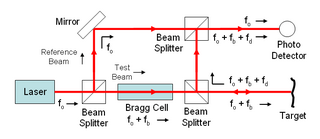
Frequency is the number of occurrences of a repeating event per unit of time. It is also occasionally referred to as temporal frequency to emphasize the contrast to spatial frequency, and ordinary frequency to emphasize the contrast to angular frequency. Frequency is expressed in units of hertz (Hz) which is equivalent to one (event) per second. The corresponding period is the time duration of one cycle in a repeating event, so the period is the reciprocal of the frequency. For example, if a heart beats at a frequency of 120 times a minute, its period, T—the time interval between beats—is half a second. Frequency is an important parameter used in science and engineering to specify the temporal rate of change observed in oscillatory and periodic phenomena, such as mechanical vibrations, audio signals (sound), radio waves, and light.

A heterodyne is a signal frequency that is created by combining or mixing two other frequencies using a signal processing technique called heterodyning, which was invented by Canadian inventor-engineer Reginald Fessenden. Heterodyning is used to shift one frequency range into another, new frequency range, and is also involved in the processes of modulation and demodulation. The two input frequencies are combined in a nonlinear signal-processing device such as a vacuum tube, transistor, or diode, usually called a mixer.
In optical communications, intensity modulation (IM) is a form of modulation in which the optical power output of a source is varied in accordance with some characteristic of the modulating signal. The envelope of the modulated optical signal is an analog of the modulating signal in the sense that the instantaneous power of the envelope is an analog of the characteristic of interest in the modulating signal.
The data link layer, or layer 2, is the second layer of the seven-layer OSI model of computer networking. This layer is the protocol layer that transfers data between nodes on a network segment across the physical layer. The data link layer provides the functional and procedural means to transfer data between network entities and may also provide the means to detect and possibly correct errors that can occur in the physical layer.

Interferometry is a technique which uses the interference of superimposed waves to extract information. Interferometry typically uses electromagnetic waves and is an important investigative technique in the fields of astronomy, fiber optics, engineering metrology, optical metrology, oceanography, seismology, spectroscopy, quantum mechanics, nuclear and particle physics, plasma physics, remote sensing, biomolecular interactions, surface profiling, microfluidics, mechanical stress/strain measurement, velocimetry, optometry, and making holograms.

Girl Genius is an ongoing comic book series turned webcomic, written and drawn by Phil and Kaja Foglio and published by their company Studio Foglio LLC under the imprint Airship Entertainment. The comic won the Hugo Award for Best Graphic Story three times, has been nominated for a Hugo Award for Best Professional Artist and twice for Eisner Awards, and won multiple WCCA awards.

Laser Doppler velocimetry, also known as laser Doppler anemometry, is the technique of using the Doppler shift in a laser beam to measure the velocity in transparent or semi-transparent fluid flows or the linear or vibratory motion of opaque, reflecting surfaces. The measurement with laser Doppler anemometry is absolute and linear with velocity and requires no pre-calibration.

In electrical engineering, homodyne detection is a method of extracting information encoded as modulation of the phase and/or frequency of an oscillating signal, by comparing that signal with a standard oscillation that would be identical to the signal if it carried null information. "Homodyne" signifies a single frequency, in contrast to the dual frequencies employed in heterodyne detection.
Dai-Guard is an anime television series, produced and animated by XEBEC, and directed by Seiji Mizushima. It aired from October 5, 1999, to March 28, 2000, on TV Tokyo, running for 26 episodes. 6 volumes of videos were released on VHS and DVD. The series also had a very brief run on Cartoon Network through Toonami's "Giant Robot Week."
In electronics, a local oscillator (LO) is an electronic oscillator used with a mixer to change the frequency of a signal. This frequency conversion process, also called heterodyning, produces the sum and difference frequencies from the frequency of the local oscillator and frequency of the input signal. Processing a signal at a fixed frequency gives a radio receiver improved performance. In many receivers, the function of local oscillator and mixer is combined in one stage called a "converter" - this reduces the space, cost, and power consumption by combining both functions into one active device.
A direct-conversion receiver (DCR), also known as homodyne, synchrodyne, or zero-IF receiver, is a radio receiver design that demodulates the incoming radio signal using synchronous detection driven by a local oscillator whose frequency is identical to, or very close to the carrier frequency of the intended signal. This is in contrast to the standard superheterodyne receiver where this is accomplished only after an initial conversion to an intermediate frequency.

A motion detector is an electrical device that utilizes a sensor to detect nearby motion. Such a device is often integrated as a component of a system that automatically performs a task or alerts a user of motion in an area. They form a vital component of security, automated lighting control, home control, energy efficiency, and other useful systems.

Resonance-enhanced multiphoton ionization (REMPI) is a technique applied to the spectroscopy of atoms and small molecules. In practice, a tunable laser can be used to access an excited intermediate state. The selection rules associated with a two-photon or other multiphoton photoabsorption are different from the selection rules for a single photon transition. The REMPI technique typically involves a resonant single or multiple photon absorption to an electronically excited intermediate state followed by another photon which ionizes the atom or molecule. The light intensity to achieve a typical multiphoton transition is generally significantly larger than the light intensity to achieve a single photon photoabsorption. Because of this, a subsequent photoabsorption is often very likely. An ion and a free electron will result if the photons have imparted enough energy to exceed the ionization threshold energy of the system. In many cases, REMPI provides spectroscopic information that can be unavailable to single photon spectroscopic methods, for example rotational structure in molecules is easily seen with this technique.
A harp is a type of stringed musical instrument.
Bat detectors are the most common way to identify the species of flying bats. There are distinct types of call which can indicate the genus, and variations in pattern and frequency which indicate the species. For readers not familiar with the different types of bat detector, there is further information below and elsewhere.
Upconversion, upconverter, or upconverting may refer to:
Noise-immune cavity-enhanced optical-heterodyne molecular spectroscopy (NICE-OHMS) is an ultra-sensitive laser-based absorption technique that utilizes laser light to assess the concentration or the amount of a species in gas phase by absorption spectrometry (AS).
Optical heterodyne detection is a method of extracting information encoded as modulation of the phase, frequency or both of electromagnetic radiation in the wavelength band of visible or infrared light. The light signal is compared with standard or reference light from a "local oscillator" (LO) that would have a fixed offset in frequency and phase from the signal if the latter carried null information. "Heterodyne" signifies more than one frequency, in contrast to the single frequency employed in homodyne detection.

A laser Doppler vibrometer (LDV) is a scientific instrument that is used to make non-contact vibration measurements of a surface. The laser beam from the LDV is directed at the surface of interest, and the vibration amplitude and frequency are extracted from the Doppler shift of the reflected laser beam frequency due to the motion of the surface. The output of an LDV is generally a continuous analog voltage that is directly proportional to the target velocity component along the direction of the laser beam.
The objective of synthetic array heterodyne detection is to isolate regions of a large area detector surface into virtual pixels. This provides the benefits of having multiple pixels without having to have physical pixels. The detector can be a simple single wire output over which all the virtual pixels can be read out continuously and in parallel. The pixels are multiplexed in the frequency domain.








